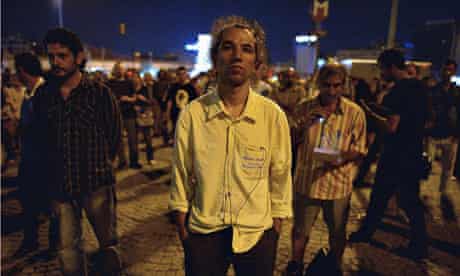https://www.theguardian.com/commentisfree/2013/jun/18/turkey-standing-man
By: Richard Seymour
Erdem Gunduz is a legend. And all he had to do to earn this status was to stand completely still. Gunduz, a performance artist and left-Kemalist, began to stand still in Taksim Square on Monday at 6pm local time. He stood, facing the Ataturk cultural centre, until 2am. It was a silent, stubborn and dignified protest against the brutality of the police response to demonstrators, which had culminated in a sinister weekend assault whose targets included medics and staff who treated the wounded. Indeed, the ministry of health went so far as to threaten to withdraw the licences of medical personnel who treated protesters injured by police.
The "standing man" exemplifies some features of the tradition of passive resistance. First, the ability to meet overpowering physical force with a determined, but passive, feat of defiance has sometimes been the death knell of recalcitrant regimes, whether it is the Shah or Marcos – because it points to resources that the protesters have which can overwhelm the state's repressive capacities. Second, passive resistance is not merely symbolic; it confuses and derails the calculations of the rulers. When the Soviet Union invaded Czechoslovakia, part of the resistance involved painting over street signs and mysteriously shutting off infrastructure.
Gunduz's protest was both an affront and a question for the authorities: beat him? Why? He's just standing there. Leave him alone? Then he wins, doesn't he?
As people began to notice what he was doing, some joined him. Not just in Taksim, but across the country, as far away as Ankara and Izmir. He went viral, acquiring the obligatory hashtag: #duranadam (standing man). Recep Tayyip Erdoğan has been known to complain about the role of social media, particularly Twitter, in these protests. Police even began arresting people for spreading "untrue information" on Twitter. The Turkish state has every reason to panic.
Social media has permitted the viral replication of protest themes, slogans and tactics. Unlike in previous so-called "Twitter revolutions", there is mass popular access to social media in Turkey. New York University documented 2m tweets reporting on the protests between 4pm and midnight on one day, Friday 28 May, when the protests went global. Hence the state's panicked attempt to restore its monopoly over truth and falsehood.
There is perhaps another reason why Gunduz's silent protest resonated, at least for some. The government's response to the protests has, of course, been staggeringly tone deaf. It began by dismissing the protests – complain all you want, we've made up our mind. Then it began violently repressing them, in such a shocking way that it sparked a national revolt. Then it began dumbfoundedly looking for scapegoats. "Terrorists", "drunks", Twitterers – Erdoğan has blamed the protests on everything except government policy.
The overarching theme, however, repeated as the prime minister addressed a big pro-government rally in Istanbul, is that the protesters are not really Turkish. Erdoğan's AKP has always been suspect for Turkish nationalists, so is perhaps all the more vehement in its patriotic bluster. The protesters, the government says, are part of a foreign conspiracy, linked to international media manipulation; the real Turkish nation does not bang pots and pans in the evening. Anyone watching the YouTube footage of protesters being hunted through the streets by Turkish police will witness the astounding spectacle of police spraying tear gas while flapping little flags. Gunduz, standing pensively before the image of Ataturk, seems to have a different idea of what is Turkish.
This is directly linked to the question of official violence which is, of course, the driving force cohering these protests, and – surprisingly, perhaps – a weak point for the government in a number of ways. Despite the fact that the AKP has secured growing electoral majorities since 2002, and fought a largely successful battle against its enemies in the state apparatuses, it never secured that broad popular consensus that would enable it to consolidate its rise.
The more stable regimes are able to use violence and coercion in ways that conserve their rule. This government has been unable to do so without provoking an existential crisis for itself – arousing a broad, potentially counter-hegemonic alliance of heteroclite elements, from Kurds and leftists to Islamists and nationalists. Its battle for the symbols of national unity, and its attempt to "other" the protesters, is symptomatic of this.
There is another sense in which state violence raises profound questions about the viability of the government. If police violence doesn't quell the uprising, what will? The government has been in nervous talks with selected groups of protesters and quietly made some grudging concessions around Gezi Park – but the protests are about so much more than that now. In desperation, the deputy prime minister, Bülent Arinç, recently threatened to unleash the armed forcesagainst the protesters.
This would be a staggering move for a government that has based its legitimacy and institutional power to a significant extent on waging a war against the old military elites and especially the "deep state". It would give the AKP's old foes a fresh lease of life if they had to be called in to crush the protests, and it's an open question whether the government would survive.
Gunduz's moving, motionless protest, is a symbol of great peril for the Turkish regime.

No comments:
Post a Comment